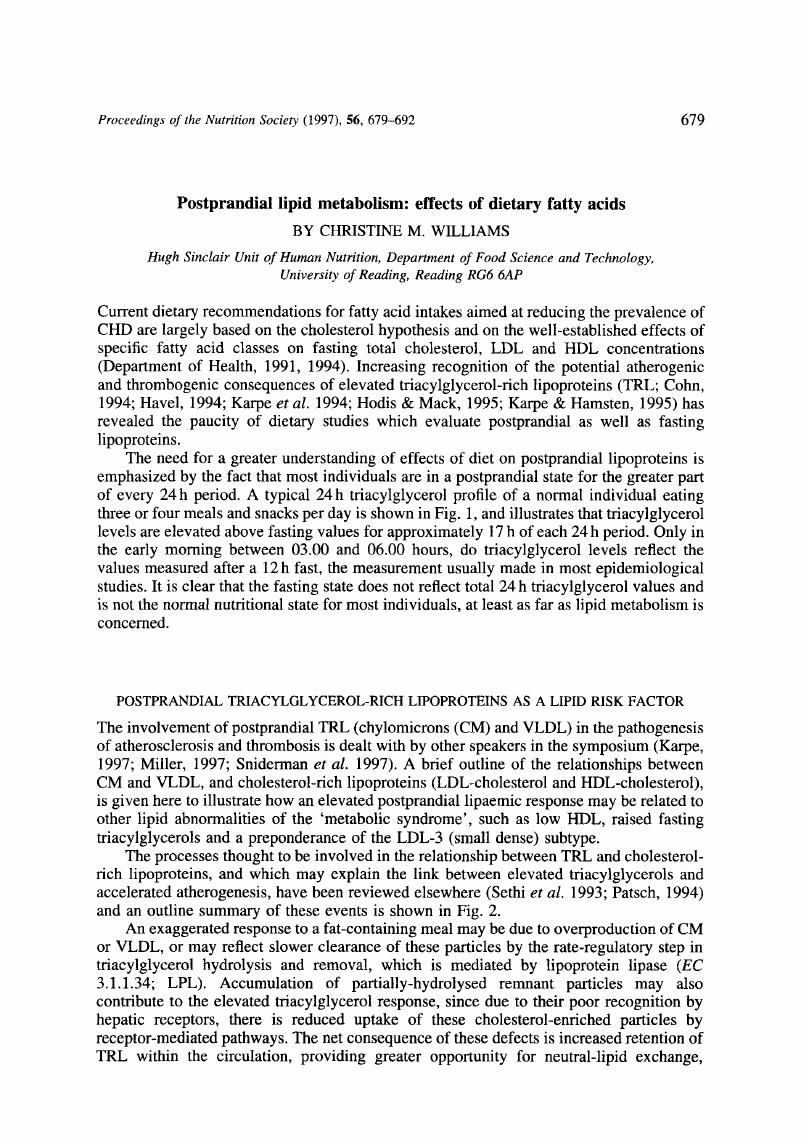Crossref Citations
This article has been cited by the following publications. This list is generated based on data provided by Crossref.
Phan, Cam T
Mortimer, Bok-Cheng
Martins, Ian J
and
Redgrave, Trevor G
1999.
Plasma clearance of chylomicrons from butterfat is not dependent on saturation: studies with butterfat fractions and other fats containing triacylglycerols with low or high melting points.
The American Journal of Clinical Nutrition,
Vol. 69,
Issue. 6,
p.
1151.
Pedersen, Anette
Marckmann, Peter
and
Sandström, Brittmarie
1999.
Postprandial lipoprotein, glucose and insulin responses after two consecutive meals containing rapeseed oil, sunflower oil or palm oil with or without glucose at the first meal.
British Journal of Nutrition,
Vol. 82,
Issue. 2,
p.
97.
Jackson, Kim G.
Zampelas, Antonios
Knapper, Jacky M. E.
Culverwell, Caroline C.
Wright, John
Gould, Barry J.
and
Williams, Christine M.
1999.
Lack of influence of test meal fatty acid composition on the contribution of intestinally-derived lipoproteins to postprandial lipaemia.
British Journal of Nutrition,
Vol. 81,
Issue. 1,
p.
51.
Minihane, Anne M.
Khan, Syrah
Leigh-Firbank, Elizabeth C.
Talmud, Philippa
Wright, John W.
Murphy, Margaret C.
Griffin, Bruce A.
and
Williams, Christine M.
2000.
ApoE Polymorphism and Fish Oil Supplementation in Subjects With an Atherogenic Lipoprotein Phenotype.
Arteriosclerosis, Thrombosis, and Vascular Biology,
Vol. 20,
Issue. 8,
p.
1990.
Gurr, Michael I.
2000.
Handbook of Olive Oil.
p.
521.
Hu, Xixuan
Jandacek, Ronald J
and
White, Wendy S
2000.
Intestinal absorption of β-carotene ingested with a meal rich in sunflower oil or beef tallow: postprandial appearance in triacylglycerol-rich lipoproteins in women.
The American Journal of Clinical Nutrition,
Vol. 71,
Issue. 5,
p.
1170.
Patsch, Wolfgang
Esterbauer, Harald
Föger, Bernhard
and
Patsch, Josef R.
2000.
Postprandial lipemia and coronary risk.
Current Atherosclerosis Reports,
Vol. 2,
Issue. 3,
p.
232.
Sharrett, A. R.
Heiss, G.
Chambless, L. E.
Boerwinkle, E.
Coady, S. A.
Folsom, A. R.
and
Patsch, W.
2001.
Metabolic and Lifestyle Determinants of Postprandial Lipemia Differ From Those of Fasting Triglycerides.
Arteriosclerosis, Thrombosis, and Vascular Biology,
Vol. 21,
Issue. 2,
p.
275.
Tholstrup, Tine
Sandström, Brittmarie
Bysted, Anette
and
Hølmer, Gunhild
2001.
Effect of 6 dietary fatty acids on the postprandial lipid profile, plasma fatty acids, lipoprotein lipase, and cholesterol ester transfer activities in healthy young men.
The American Journal of Clinical Nutrition,
Vol. 73,
Issue. 2,
p.
198.
Schurgers, L.J.
and
Vermeer, C.
2001.
Corn oil-induced decrease in arterial thrombosis tendency may be related to altered plasma vitamin K transport.
Journal of Lipid Research,
Vol. 42,
Issue. 7,
p.
1120.
Mattes, Richard D.
2001.
Oral Exposure to Butter, but Not Fat Replacers Elevates Postprandial Triacylglycerol Concentration in Humans.
The Journal of Nutrition,
Vol. 131,
Issue. 5,
p.
1491.
2001.
Abstracts of Original Communications.
Proceedings of the Nutrition Society,
Vol. 60,
Issue. 4b,
p.
171A.
Schurgers, Leon J.
Shearer, Martin J.
Soute, Berry A.M.
Elmadfa, Ibrahim
Harvey, Julia
Wagner, Karl-Heinz
Tomasch, Richard
and
Vermeer, Cees
2002.
Novel effects of diets enriched with corn oil or with an olive oil/sunflower oil mixture on vitamin K metabolism and vitamin K-dependent proteins in young men.
Journal of Lipid Research,
Vol. 43,
Issue. 6,
p.
878.
Williams, C. M.
and
Jackson, K. G.
2002.
Inulin and oligofructose: effects on lipid metabolism from human studies.
British Journal of Nutrition,
Vol. 87,
Issue. S2,
p.
S261.
Robertson, M Denise
Jackson, Kim G
Fielding, Barbara A
Morgan, Linda M
Williams, Christine M
and
Frayn, Keith N
2002.
Acute ingestion of a meal rich in n−3 polyunsaturated fatty acids results in rapid gastric emptying in humans,,.
The American Journal of Clinical Nutrition,
Vol. 76,
Issue. 1,
p.
232.
Jackson, Kim G
Robertson, M Denise
Fielding, Barbara A
Frayn, Keith N
and
Williams, Christine M
2002.
Olive oil increases the number of triacylglycerol-rich chylomicron particles compared with other oils: an effect retained when a second standard meal is fed,,,.
The American Journal of Clinical Nutrition,
Vol. 76,
Issue. 5,
p.
942.
Delzenne, Nathalie M.
and
Williams, Christine M.
2002.
Prebiotics and lipid metabolism.
Current Opinion in Lipidology,
Vol. 13,
Issue. 1,
p.
61.
Mekki, Nadia
Charbonnier, Monique
Borel, Patrick
Leonardi, Jeannie
Juhel, Christine
Portugal, Henri
and
Lairon, Denis
2002.
Butter Differs from Olive Oil and Sunflower Oil in Its Effects on Postprandial Lipemia and Triacylglycerol-Rich Lipoproteins after Single Mixed Meals in Healthy Young Men.
The Journal of Nutrition,
Vol. 132,
Issue. 12,
p.
3642.
Finnegan, Yvonne E
Minihane, Anne M
Leigh-Firbank, Elizabeth C
Kew, Samantha
Meijer, Gert W
Muggli, Reto
Calder, Philip C
and
Williams, Christine M
2003.
Plant- and marine-derived n−3 polyunsaturated fatty acids have differential effects on fasting and postprandial blood lipid concentrations and on the susceptibility of LDL to oxidative modification in moderately hyperlipidemic subjects.
The American Journal of Clinical Nutrition,
Vol. 77,
Issue. 4,
p.
783.
Brynes, Audrey E.
Edwards, C. Mark
Ghatei, Mohammed A.
Dornhorst, Anne
Morgan, Linda M.
Bloom, Stephen R.
and
Frost, Gary S.
2003.
A randomised four-intervention crossover study investigating the effect of carbohydrates on daytime profiles of insulin, glucose, non-esterified fatty acids and triacylglycerols in middle-aged men.
British Journal of Nutrition,
Vol. 89,
Issue. 2,
p.
207.



